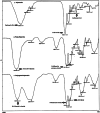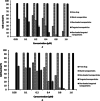Luteinizing hormone-releasing hormone targeted poly(methyl vinyl ether maleic acid) nanoparticles for doxorubicin delivery to MCF-7 breast cancer cells
- PMID: 27463791
- PMCID: PMC8676489
- DOI: 10.1049/iet-nbt.2015.0056
Luteinizing hormone-releasing hormone targeted poly(methyl vinyl ether maleic acid) nanoparticles for doxorubicin delivery to MCF-7 breast cancer cells
Abstract
The purpose of this study was to design a targeted anti-cancer drug delivery system for breast cancer. Therefore, doxorubicin (DOX) loaded poly(methyl vinyl ether maleic acid) nanoparticles (NPs) were prepared by ionic cross-linking method using Zn(2+) ions. To optimise the effect of DOX/polymer ratio, Zn/polymer ratio, and stirrer rate a full factorial design was used and their effects on particle size, zeta potential, loading efficiency (LE, %), and release efficiency in 72 h (RE72, %) were studied. Targeted NPs were prepared by chemical coating of tiptorelin/polyallylamin conjugate on the surface of NPs by using 1-ethyl-3-(3-dimethylaminopropyl) carboiimid HCl as cross-linking agent. Conjugation efficiency was measured by Bradford assay. Conjugated triptorelin and targeted NPs were studied by Fourier-transform infrared spectroscopy (FTIR). The cytotoxicity of DOX loaded in targeted NPs and non-targeted ones were studied on MCF-7 cells which overexpress luteinizing hormone-releasing hormone (LHRH) receptors and SKOV3 cells as negative LHRH receptors using Thiazolyl blue tetrazolium bromide assay. The best results obtained from NPs prepared by DOX/polymer ratio of 5%, Zn/polymer ratio of 50%, and stirrer rate of 960 rpm. FTIR spectrum confirmed successful conjugation of triptorelin to NPs. The conjugation efficiency was about 70%. The targeted NPs showed significantly less IC50 for MCF-7 cells compared to free DOX and non-targeted NPs.
Figures







Similar articles
-
Targeted delivery of doxorubicin to breast cancer cells by magnetic LHRH chitosan bioconjugated nanoparticles.Int J Biol Macromol. 2016 Dec;93(Pt A):1192-1205. doi: 10.1016/j.ijbiomac.2016.07.025. Epub 2016 Sep 28. Int J Biol Macromol. 2016. PMID: 27693338
-
In vitro assessment of polyethylene glycol-coated iron oxide nanoparticles integrating luteinizing hormone releasing-hormone targeted magnetic hyperthermia and doxorubicin for lung and breast cancer cells.Biointerphases. 2025 May 1;20(3):031001. doi: 10.1116/6.0004228. Biointerphases. 2025. PMID: 40488548
-
Chondroitin/doxorubicin nanoparticulate polyelectrolyte complex for targeted delivery to HepG2 cells.IET Nanobiotechnol. 2017 Mar;11(2):164-172. doi: 10.1049/iet-nbt.2015.0109. IET Nanobiotechnol. 2017. PMID: 28476999 Free PMC article.
-
Doxorubicin-loaded star-shaped copolymer PLGA-vitamin E TPGS nanoparticles for lung cancer therapy.J Mater Sci Mater Med. 2015 Apr;26(4):165. doi: 10.1007/s10856-015-5498-z. Epub 2015 Mar 20. J Mater Sci Mater Med. 2015. PMID: 25791459
-
Reversibly crosslinked hyaluronic acid nanoparticles for active targeting and intelligent delivery of doxorubicin to drug resistant CD44+ human breast tumor xenografts.J Control Release. 2015 May 10;205:144-54. doi: 10.1016/j.jconrel.2015.01.012. Epub 2015 Jan 14. J Control Release. 2015. PMID: 25596560
Cited by
-
Decapeptide functionalized targeted mesoporous silica nanoparticles with doxorubicin exhibit enhanced apoptotic effect in breast and prostate cancer cells.Int J Nanomedicine. 2018 Nov 19;13:7669-7680. doi: 10.2147/IJN.S184634. eCollection 2018. Int J Nanomedicine. 2018. PMID: 30538451 Free PMC article.
References
-
- American Cancer Society : ‘Breast cancer facts and figures 2011–2012’ (American Cancer Society, Atlanta, Ga, USA, 2012)
-
- Jones K.L.: ‘Breast cancer’, in Alldrege B.K. Corelli R.L. Ernst M.E. (Eds.): ‘Koda‐Kimble and Young's Applied Thrapeutics, the clinical use of Drugs’ (Lippincott Williams and Wilkins, New York, 2012, 10th edn.), pp. 2129 –2199
MeSH terms
Substances
LinkOut - more resources
Full Text Sources
Other Literature Sources
Medical

